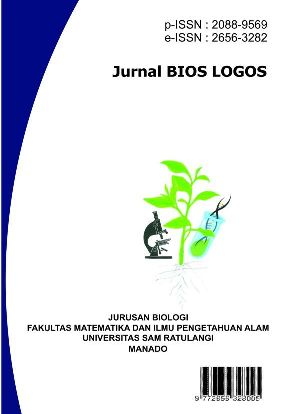Isolation and Identification of Thermophilic Bacteria from Lahendong Hot Spring, North Sulawesi
DOI:
https://doi.org/10.35799/jbl.v13i2.50184Keywords:
Bacillus cereus, Geobacillus kaustophilus, Geobacillus lituanicus, Lipase Thermostable enzyme, Lahendong Hot SpringAbstract
Thermophilic bacteria are a group of procaryotic organisms that can grow in high temperature around 450C until 900C. Thermophilic bacteria are able to produce lipase thermostable enzyme. Lipase thermostable enzymes produced from thermophilic bacteria are able to catalyze the hydrolysis of triglycerides into glycerol and free fatty acids and the synthesis of esters in organic solvents. Lipase thermostable enzymes are potential to be used in industrial production. Lipase enzymes have been used for the production of laundry detergents as additives or to replace chemical detergents because of their environmental friendliness. This research was aimed to isolates and identified themophilic bacteria from Lahendong hot springs, North Sulawesi and to conduct the morphological characterization, biochemical test, and molecular identification with 16S rRNA. Results showed that isolates obtained from the- Lahendong hot spring have high similarities with Geobacillus kaustophilus, Bacillus cereus, and Geobacillus lituanicus. The three isolates are able to produce lipase thermostbale enzyme.
References
Asnawi, I, Natsir, H, Hariani, N (2014) Exploration of lipolytic enzymes-producing microbes in Lemo Susu hot springs, Pinrang, South Sulawesi. 1st International Conference on Science.
Alcamo, I. E (2001) Fundamentals of microbiology. Jones and Bartlett Publishers, Inc., New York, 6th edition.
Akihary, V, Beivy, K (2020) Utilization of 16s rRNA Gene as a Bacterial Identification Device for Research in Indonesia. Pharmacon. 9(1): 16-22.
Cappucino, JG, Sherman N (1987) Microbiology a Laboratory Manual. 7th Ed. Pearson Education, Inc. Publishing as Benjamin Cummings. San Francisco.
Colla, L.M, Rizzardi, J, Pinto, M.H, Reinehr, C, Bertolin, T.E, Costa (2010) Production of Lipase and Biosurfactants Together with Submerged and Solid Bioproozes. Biore. technology.
Dessy A, Winni A, Rita H (2019) Isolation of lipase-producing bacteria from hot springs. Mulawarman University. Atomic Journal 6(1): 32-34.
Dutta, S, Ray, L (2009). Production and Characterization of an Alkaline Thermostable Crude Lipase from an Isolated Strain of Bacillus cereus C7. Applied Biochemistry and Biotechnology, 159(1): 142–154
Janda, J, Abbott, S, L, (2007) 16S rRNA Gene Sequencing for Bacterial Identification in the Diagnostic Laboratory: Pluses, Perils, and Pitfalls. Journal of Clinical Microbiology, 45: 2761-2764.
Jefferson P., Alfrie R (2020) Geochemical Analysis of Surface Manifestation Fluids in the Lahendong Geothermal Area. Journal of Chemistry 5(1): 45-48.
Kumar, Nussinov (2001) Isolation and Optimization of Thermophilic Bacterial Proteases from Tangkuban Perahu Hot Springs, Bandung. Thesis. IPB. Bogor.
Kuisiene, N (2004) Geobacillus lituanicus sp. nov. Internasional journal of systematic and evolusionary Microbiology. 54(6): 1991–1995.
Labeda, DP (1990) Isolation of Biotechnological Organisms from nature. McGraw-Hill. New York.
Marthariana, Dini (2010) Characterization of Thermophilic Lactic Acid Bacteria from the White Crater of Mount Pancar Bogor.Skripsi.IPB.Bogor
Ozdemir, F. I., Tulek, A., & Erdogan, D. 2021. Identification and Heterologous Production of a Lipase from Geobacillus kaustophilus DSM 7263T and Tailoring Its N-Terminal by a His-Tag Epitope. The Protein Journal, 40(3): 436–447.
Paskevicius, A., (2001) Lipase activity of yeast and yeasts-like fungi functioning under natural conditions, Institute of Botany, London.
Putranto, A. R, Santoso, D, Tri-Panji, S, Budiani, A. (2006). Characterization of the lipase-encoding gene from molds Rhizopus oryzae and Absidia corymbifera. Estate Towers, 74(1): 23-32.
Reetz, M. T (2013). Biocatalysis in Organic Chemistry and Biotechnology: Past, Present, and Future. Journal of the American Chemical Society, 135(34): 12480-12496.
Sasa, S (2020) Isolation and Characterization of Thermophilic Bacteria from Hot Springs in Pincara Village, Masamba District. Cokroaminoto Paloppo University. THESIS.
Sanchez, S. (2011) Enzim AL dan Biokonversi dari Signifikansi Industri, Farmasi, dan Bioteknologi.Organisasi Proozes Res. 15: 224–230.
Septiani, S. (2017) Isolation and charaterization of thermostable lipase from thermophilic bacteria (Isolate AL96). Doctoral dissertation, Bandung Institute of Technology.
Susanti R and Fidia F (2017) Enzyme Technology. Yogyakarta: CV. Andi Offset.
Singleton, P, D. Sainsbury (2006) Dictionary of Microbiology and Molecular Biology 3rd Edition. John Wiley and Sons, Sussex, England
Siahaan, E.E (1999) Fault structure evaluation in Lahendong Field based on aerial photo and landsat imagery, Pertamina Internal Report (in Indonesian).
Vasiee, A., Behbahani, B. A., Yazdi, F. T., & Moradi, S (2016) Optimization of the production conditions of the lipase produced by Bacillus cereus from rice flour through Plackett-Burman Design (PBD) and response surface methodology (RSM). Microbial Pathogenesis, 101: 36–43.
Zhu, Y., Li, H., Ni, H., Xiao, A., Li, L., & Cai, H (2014) Molecular cloning and characterization of a thermostable lipase from deep-sea thermophile Geobacillus sp. EPT9. World Journal of Microbiology and Biotechnology, 31(2): 295–306.
Downloads
Published
How to Cite
Issue
Section
License
Copyright (c) 2023 Christiana Abrita Nathania Corneles, Feky Mantiri, Marina Singkoh

This work is licensed under a Creative Commons Attribution-ShareAlike 4.0 International License.




